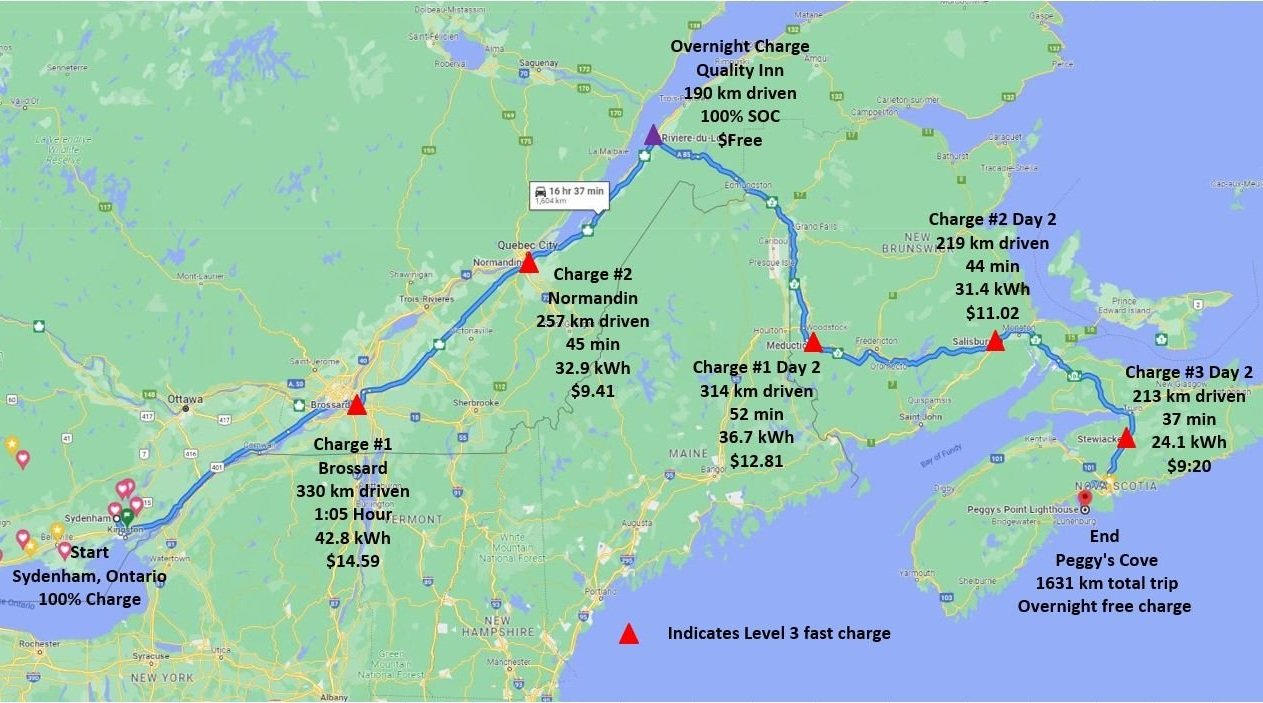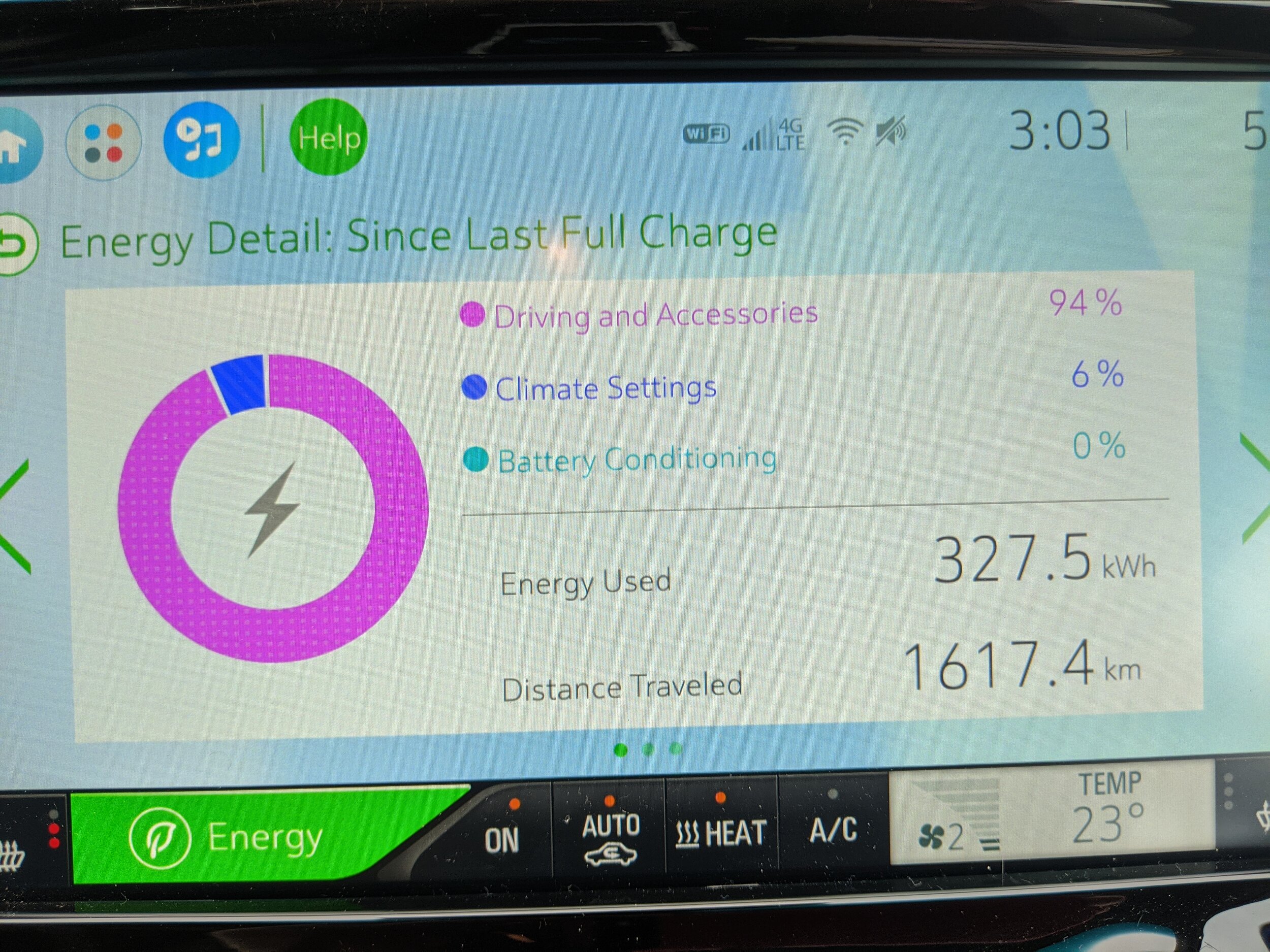
Long Distance EV trips are totally doable to many places in Canada

Sydenham, Ontario to Peggy’s Cove - 1631 km by EV
Here are actual charging stops and costs on a May 24-25, 2022 trip. The EV used was a 2019 Chevy Bolt with the updated 66 kWh capacity battery. It is a relatively slow charging EV compared to most newer EVs, but the total time charging was just 3.5 hours over two driving days.
May 2022 - Sydenham, Ontario to Peggy’s Cove, Nova Scotia EV Trip.
The total trip was 1631 km. The blue dots show the distance driven between charges.
The first day of travel is represented by the first three blue dots, i.e. to about 780 km where we overnighted and received a 100% charge on a free Level 2 charger at the hotel. the distance driven in the first leg of each day is longer due to the battery having a 100% SOC due to the overnight charging. The weather was dry and about 15-20 C. We drove at 110-120 kph.
Efficiency in an EV is measured by km driven per kWh unit of electricity. This is expressed as kWh/100km. Most passenger car EVs in good weather will have efficiencies of about 14 to 20 kWh/100km. On this trip in fair dry weather, the Bolt used between 14 and 18 kWh/100 km. (S. Lapp, April 2021)
Here are the costs as billed by the charging companies including taxes. The total was $43.98 for the 1631 km trip. The charges at the half way and final destinations were no charge at the accommodations. This was about 1/2 of the cost of the same trip a year earlier in terrible weather than made the car much less efficient. (S. Lapp, June April 2021)
Long distance EV travel is now very feasible in much of Canada because of the recent proliferation of high rate Level 3 chargers. The graphs show data for a May 24-25, 2022 Sydenham, Ontario to Peggy’s Cove trip. A total one-way distance of 1631 km over two days. Both days were mild and dry, ideal conditions. Notes from experience about long distance EV trips:For long distances, you need a cell phone to use the various apps that are required to find and operate the chargers you will encounter. Petro Canada chargers will take a credit card with no app, many others do not. I used “A Better Route Planner” and “Plugshare” apps along with the individual charging company apps.You might initially think that on a long trip you’ll drive the full range of your EV on each charge. However, you’ll pull into a charger before “0” km range are left, and you’ll only charge to maybe 70% state of charge (SOC). The reason you’ll leave before the battery is full are twofold1/ You won’t charge to “full” because all EVs reduce the charging rate as the battery becomes more charged. The chargers charge by the minute (Utility Regulations) so once the charge kW are reduced at higher states of charge, you are paying more for each kWh. If you wait for the last few kWh to get an EV to 100% , you’re paying much more for those last few kWh of energy. This is an imperfect system and let’s hope the rate structures evolve to be more optimal.2/ Additionally, once the charge rate drops off, you are getting fewer km of range for each minute you sit at the charger. That means it could take a very long time ot get to 100% SOC. I found with the 2019 Chevy Bolt, at about 60%-70% charged, it made sense to start driving again.
For this trip three apps were used. “PlugShare” to find chargers, then the apps to pay using “Electrique Circuit” and “Flo”. On my first few longer trips I had to do more thinking and learning, but now on this trip I found I did much less planning around charging, it is just easier having done it a few times.Some charging companies are allowing their charge cards to be used on other systems, but it can be a bit confusing to the initial user. So, plot your route, check out the brands of chargers you’ll be using, and load the required apps.Cold, snow, rain, altitude gain, high speeds or a heavy vehicle load will increase your energy consumption, possible quite significantly. These conditions of course also impact a gasoline car fuel consumption, but we don’t notice it as much. An EV with a 400 km highway range in ideal conditions may have a 200 km range at highway speeds in heavy snow and cold weather. See below for results of the same Sydenham to Peggy’s Cove trip in terrible weather.If your hotel has a Level 2 charger, it is great to charge overnight, but if they are charging an hourly rate, it may result in a higher cost than a shorter charge at a Level 3 station. Many Level 2 chargers are $1.50 per hour. The advantage of the Level 2 charge is that the car will have a 100% full battery in the morning. On this trip the hotel had a free Level 2 so we were able to leave with a 100% SOC battery. It probably cost the hotel about $3-5, many hotels with chargers just absorb this cost.At the charging stops I would walk and stretch, do my email, get a snack, use a washroom and by the time I did these things, 20-45 minutes had elapsed and the car was 70% charged, so off we went.The 1631 km trip cost $43.98 in billing from the Level 3 chargers. At the destination AirBNB the charging was again free.When planning the Level 3 charging, you’ll likely stop when the car’s remaining range is 40-70 km, that way if for any reason the chosen charger isn’t working, or there are several people waiting to use it, I would likely be able to get to the next available charger. On this May trip, there was no waiting at any charger.Conclusion. Long distance travel is an EV is entirely possible, but you need to understand your car range, allow for the charge rate of your car, know the charger networks and apps and choose a charger with the idea that you may need to have a plan B.Ontario and Quebec have very low GHG intensity to their electricity production, while New Brunswick and Nova Scotia still have quite a bit of fossil fuel fired generation. All the data supports EVs being better on GHG than ICE cars even on coal fired electricity, so I rest easy knowing the EV trip produces far fewer GHGs.Tesla owners use of the Tesla Supercharger network and Tesla has done a good job of providing many Superchargers across Canada. Tesla may open the network to non-Teslas, they have already done so in selected EU countries, so watch for that news.
April 2021 - Kingston to Halifax EV Trip - Terrible weather and using the pre-recall smaller 60 kWh Battery - more charging stops were required
Here are data from an April 2021 long distance drive in a 2019 Chevy Bolt over two days from Kingston, Ontario to south of Halifax. The total trip was 1614 km. The red dots show the Chevy Bolt energy consumption (efficiency) at each charging stop in kWh/100km of travel at a speed of roughly 100-120 kph on the Trans Canada highway.
The first day of travel is represented by the first four red dots, i.e. to about 750 km where I overnighted (no charger at the hotel). The weather was dry and about 5-10 C. I drove at 110-120 kph. The Bolt energy use was normal, about 17 kWh/100 km at 110-115 kph.
The second day was snow for the first few hours then very heavy rain, with near freezing temperatures the whole way. The energy consumption went way up, to as high as 25 kWh/100 km, not due to heating but due to the resistance of the snow, or the 1 cm deep standing water on the roads, and the cold temperatures that make the air more dense and rolling resistance of tires higher. (S. Lapp, April 2021)
You might think you would just drive a few hundred kilometers per charge and that would be an easily repeated pattern for the trip. In reality, due to the weather (especially the terrible weather the second day), the charger locations and being human and needing food, bathrooms and breaks form the terrible driving conditions, the trip charging was not always predictable. On the second day because of the snow and rain and driver fatigue, I sometimes had to and sometimes chose to drive fewer kilometers per charge. (S. Lapp, April 2021)
By using the available data from the Bolt, and the data from the charging session providers I was able to create a battery State of Charge (SOC) graph. You’ll notice there is not much charging above 60-70% SOC, that’s because the chargers bill by the minute and the charge rate by that SOC has dropped to below 30 kW and therefore each kWh of energy gets expensive, it is better to drive and lower the battery SOC to where it will charge at 50 kW again. A car with a faster charging rate presents a different scenario. As to how low a SOC to go to, that depends on where the next chargers are. On the second day I had to charge more often as the rain and snow caused the car to use energy more quickly, I took more breaks due to the terrible driving conditions, and I had trouble with one charger (at 1500 km) and could not get a full charge. (s. Lapp, April 2021)
Here are the costs as billed including taxes at each charge stop. The total was $101.89 for the 1614 km trip. (S. Lapp, April 2021)
April 1st 2021 through New Brunswick. A cruel April fools day! The wipers have just moved to the up position and the windshield is already obscured by fresh rain. (S. Lapp, April 2021)
The end of trip energy pie chart shows 6% of the trip energy was used for the heating and defrosting. There is a difference between “charge energy” of 350 kWh, and “Energy used” of 328 kWh, due to the battery charge/discharge efficiency, which worked out to 93% in this drive. I haven’t done exhaustive analysis to see how accurate that is. (S. Lapp, April 2021)
A Long Distance Trip (April 2021)
To the left are data from an April 2021 trip from Sydenham, Ontario, to Peggy’s Cove, Nova Scotia, with a 2019 Chevy Bolt. A total trip distance of 1614 km over two days. The first day was dry and about 5-10 C temperature. On the second day the weather was terrible, it snowed initially and then rained heavily for almost the entire day. The added rolling resistance and colder temperatures of this trip resulted in much higher electricity consumption and more frequent charging stops.





